KootK
Structural
- Oct 16, 2001
- 18,575
I'm reviewing a design where an existing round concrete column is being encased with 6" more concrete all around. Roughening for composite behavior, new cage, and all that jazz.
I have this picture in my head where the new concrete tries to shrink but is restrained from doing so by it's bond with the existing concrete. That, in turn, result ins distributed cracking and puts the new longitudinal rebar in tension and compression alternately from one crack to the next, in effect, prestresing the original column.
So my questions are these:
1) Am I considering this correctly?
2) With a prestressed column that one might get from a precaster, the prestress does not add to the axial load on the column for stability purposes. The same would be true here, yes?
3) Would you be specifying a low shrinkage mix for this application? For what it's worth, the contractor would like to use SCC for obvious reasons.
4) If you were to specify a low shrinkage mix, how would you determine the performance characteristics to specify here?
5) The new concrete will be rather heavily reinforced. Should that effectively eliminate my shrinkage concern on it's own?
This is a stocky parkade column that is in need of additional compression capacity. Moments and slenderness will be ancillary concerns.
I like to debate structural engineering theory -- a lot. If I challenge you on something, know that I'm doing so because I respect your opinion enough to either change it or adopt it.
I have this picture in my head where the new concrete tries to shrink but is restrained from doing so by it's bond with the existing concrete. That, in turn, result ins distributed cracking and puts the new longitudinal rebar in tension and compression alternately from one crack to the next, in effect, prestresing the original column.
So my questions are these:
1) Am I considering this correctly?
2) With a prestressed column that one might get from a precaster, the prestress does not add to the axial load on the column for stability purposes. The same would be true here, yes?
3) Would you be specifying a low shrinkage mix for this application? For what it's worth, the contractor would like to use SCC for obvious reasons.
4) If you were to specify a low shrinkage mix, how would you determine the performance characteristics to specify here?
5) The new concrete will be rather heavily reinforced. Should that effectively eliminate my shrinkage concern on it's own?
This is a stocky parkade column that is in need of additional compression capacity. Moments and slenderness will be ancillary concerns.
I like to debate structural engineering theory -- a lot. If I challenge you on something, know that I'm doing so because I respect your opinion enough to either change it or adopt it.




![[idea] [idea] [idea]](/data/assets/smilies/idea.gif)
![[r2d2] [r2d2] [r2d2]](/data/assets/smilies/r2d2.gif)